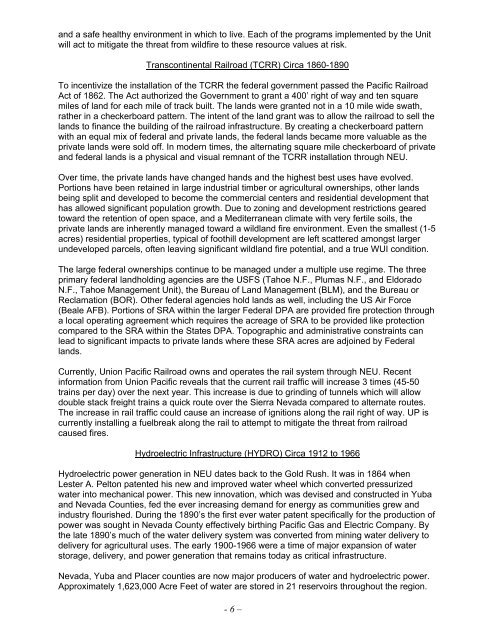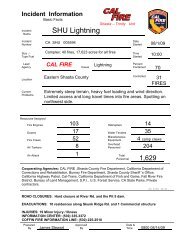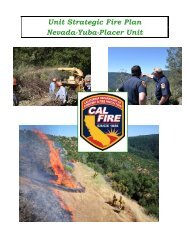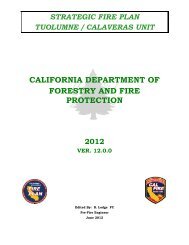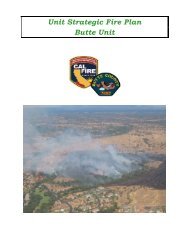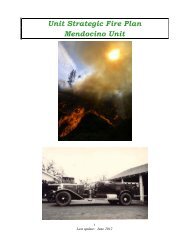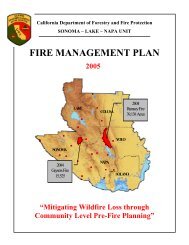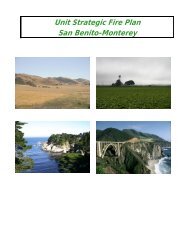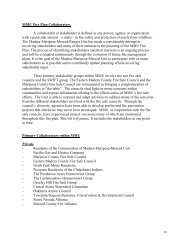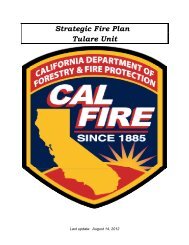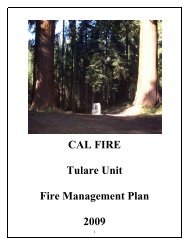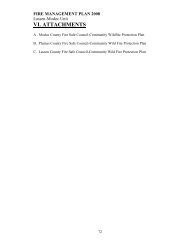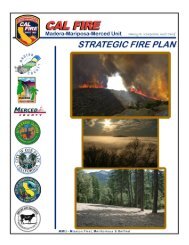Nevada-Yuba-Placer Strategic Fire Plan 2011 - Board of Forestry ...
Nevada-Yuba-Placer Strategic Fire Plan 2011 - Board of Forestry ...
Nevada-Yuba-Placer Strategic Fire Plan 2011 - Board of Forestry ...
You also want an ePaper? Increase the reach of your titles
YUMPU automatically turns print PDFs into web optimized ePapers that Google loves.
and a safe healthy environment in which to live. Each <strong>of</strong> the programs implemented by the Unit<br />
will act to mitigate the threat from wildfire to these resource values at risk.<br />
Transcontinental Railroad (TCRR) Circa 1860-1890<br />
To incentivize the installation <strong>of</strong> the TCRR the federal government passed the Pacific Railroad<br />
Act <strong>of</strong> 1862. The Act authorized the Government to grant a 400’ right <strong>of</strong> way and ten square<br />
miles <strong>of</strong> land for each mile <strong>of</strong> track built. The lands were granted not in a 10 mile wide swath,<br />
rather in a checkerboard pattern. The intent <strong>of</strong> the land grant was to allow the railroad to sell the<br />
lands to finance the building <strong>of</strong> the railroad infrastructure. By creating a checkerboard pattern<br />
with an equal mix <strong>of</strong> federal and private lands, the federal lands became more valuable as the<br />
private lands were sold <strong>of</strong>f. In modern times, the alternating square mile checkerboard <strong>of</strong> private<br />
and federal lands is a physical and visual remnant <strong>of</strong> the TCRR installation through NEU.<br />
Over time, the private lands have changed hands and the highest best uses have evolved.<br />
Portions have been retained in large industrial timber or agricultural ownerships, other lands<br />
being split and developed to become the commercial centers and residential development that<br />
has allowed significant population growth. Due to zoning and development restrictions geared<br />
toward the retention <strong>of</strong> open space, and a Mediterranean climate with very fertile soils, the<br />
private lands are inherently managed toward a wildland fire environment. Even the smallest (1-5<br />
acres) residential properties, typical <strong>of</strong> foothill development are left scattered amongst larger<br />
undeveloped parcels, <strong>of</strong>ten leaving significant wildland fire potential, and a true WUI condition.<br />
The large federal ownerships continue to be managed under a multiple use regime. The three<br />
primary federal landholding agencies are the USFS (Tahoe N.F., Plumas N.F., and Eldorado<br />
N.F., Tahoe Management Unit), the Bureau <strong>of</strong> Land Management (BLM), and the Bureau or<br />
Reclamation (BOR). Other federal agencies hold lands as well, including the US Air Force<br />
(Beale AFB). Portions <strong>of</strong> SRA within the larger Federal DPA are provided fire protection through<br />
a local operating agreement which requires the acreage <strong>of</strong> SRA to be provided like protection<br />
compared to the SRA within the States DPA. Topographic and administrative constraints can<br />
lead to significant impacts to private lands where these SRA acres are adjoined by Federal<br />
lands.<br />
Currently, Union Pacific Railroad owns and operates the rail system through NEU. Recent<br />
information from Union Pacific reveals that the current rail traffic will increase 3 times (45-50<br />
trains per day) over the next year. This increase is due to grinding <strong>of</strong> tunnels which will allow<br />
double stack freight trains a quick route over the Sierra <strong>Nevada</strong> compared to alternate routes.<br />
The increase in rail traffic could cause an increase <strong>of</strong> ignitions along the rail right <strong>of</strong> way. UP is<br />
currently installing a fuelbreak along the rail to attempt to mitigate the threat from railroad<br />
caused fires.<br />
Hydroelectric Infrastructure (HYDRO) Circa 1912 to 1966<br />
Hydroelectric power generation in NEU dates back to the Gold Rush. It was in 1864 when<br />
Lester A. Pelton patented his new and improved water wheel which converted pressurized<br />
water into mechanical power. This new innovation, which was devised and constructed in <strong>Yuba</strong><br />
and <strong>Nevada</strong> Counties, fed the ever increasing demand for energy as communities grew and<br />
industry flourished. During the 1890’s the first ever water patent specifically for the production <strong>of</strong><br />
power was sought in <strong>Nevada</strong> County effectively birthing Pacific Gas and Electric Company. By<br />
the late 1890’s much <strong>of</strong> the water delivery system was converted from mining water delivery to<br />
delivery for agricultural uses. The early 1900-1966 were a time <strong>of</strong> major expansion <strong>of</strong> water<br />
storage, delivery, and power generation that remains today as critical infrastructure.<br />
<strong>Nevada</strong>, <strong>Yuba</strong> and <strong>Placer</strong> counties are now major producers <strong>of</strong> water and hydroelectric power.<br />
Approximately 1,623,000 Acre Feet <strong>of</strong> water are stored in 21 reservoirs throughout the region.<br />
- 6 –


